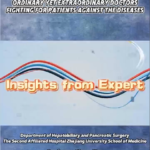
Editor's Note: Liver fibrosis is the result of damage to the liver by pathogenic factors, leading to chronic, repeated abnormalities in liver function and the deposition of collagen and other proteins. It is a crucial factor influencing the prognosis of chronic liver disease and a necessary stage in the progression to cirrhosis. Recently, at the 25th National Conference on Traditional Chinese Medicine and Hepatobiliary Diseases organized by the Chinese Association of Traditional Chinese Medicine, Professor Jingtao Li from the Affiliated Hospital of Shaanxi University of Traditional Chinese Medicine presented the latest clinical research advancements in the prevention and treatment of liver fibrosis using Traditional Chinese Medicine (TCM). The multi-component, multi-target therapeutic features of TCM, along with the significant efficacy of several representative drugs, provide strong scientific support for the application of TCM in combating liver fibrosis.Understanding Liver Fibrosis
Liver fibrosis refers to a pathological stage characterized by diffuse proliferation and deposition of fibrous connective tissue as a result of inflammation and necrosis of liver parenchyma caused by various pathogenic factors. It is a critical pathway for the progression of chronic liver disease to end-stage liver disease, potentially advancing to cirrhosis, causing portal hypertension, and liver function impairment, which severely threaten patients’ health. The pathogenesis of liver fibrosis involves multiple aspects such as hepatocyte injury, liver inflammation, activation of hepatic stellate cells, and extracellular matrix deposition. Currently, there are no approved Western medicines for the treatment of liver fibrosis. TCM has a long history of treating liver diseases with its multi-component and multi-target characteristics. Supported by major national projects like the 12th and 13th Five-Year Plans for infectious diseases, the clinical research outcomes in recent years on TCM for liver fibrosis prevention and treatment are promising.
Research Phases of TCM in Preventing and Treating Liver Fibrosis
The research on TCM in the prevention and treatment of liver fibrosis has generally gone through three phases:
- Clinical Exploration Period (1950s-1970s): During this period, the understanding of liver fibrosis was often linked with its pathological outcome—cirrhosis. Treatment strategies were based on TCM syndromes such as “hypochondriac pain,” “jaundice,” and “masses.”
- Experimental Research Period (Late 1970s to Early 1990s): This period involved experimental verification of the anti-fibrotic effects of TCM, with representative studies on formulations like Qianggan Rujiantang, Fufang 861, Danshen, Tao Ren and its extracts, Glycyrrhizin, and Tetrandrine.
- New Drug Clinical Trials and Mechanism Research Period (Post-1990s): Guided by principles of new TCM drug research and evidence-based medicine, this period utilized multicenter, randomized controlled trials, and liver histopathology to evaluate the clinical efficacy of TCM in anti-liver fibrosis. Modern life science methods were also used to study the mechanisms and compatibility principles of effective TCM.
Currently, the basic TCM pathogenesis of liver fibrosis is generally considered to be deficiency leading to stasis and accumulation, with blood stasis being the manifestation (branch) and deficiency being the root (root). Therefore, the primary treatment methods are activating blood and resolving stasis, benefiting qi, and nourishing yin. Depending on different stages of liver fibrosis and patient constitution, different syndromes may manifest, commonly including damp-heat in the liver and gallbladder, liver stagnation with spleen deficiency, and liver-kidney yin deficiency. In syndrome differentiation treatment, the basic treatment methods should be flexibly combined with syndrome differentiation.
New Clinical Evidence for TCM Reversing Liver Fibrosis
Due to the previous lack of rigorously standardized clinical research, high-level evidence-based support for TCM in treating liver fibrosis has been insufficient. Supported by major national projects, recent high-quality clinical research results have emerged, showcasing the unique advantages of TCM in anti-liver fibrosis with representative drugs like Fuzheng Huayu Tablets (Capsules), Fufang Biejia Ruangan Tablets, and Anluo Huaxian Pills.
A multicenter, randomized, double-blind, placebo-controlled clinical efficacy evaluation study of Fufang Biejia Ruangan Tablets combined with Entecavir (ETV) in the treatment of liver fibrosis in chronic hepatitis B (CHB) patients demonstrated that the liver fibrosis reversal rate in the combination group was significantly higher than in the control group. In the follow-up study, patients continuing with the combination treatment for five years showed significantly lower cumulative incidence rates of hepatocellular carcinoma (HCC) and liver-related mortality compared to the ETV alone group.
Another study evaluating the clinical efficacy of Fuzheng Huayu (FZHY) combined with ETV in CHB patients with liver fibrosis showed that the fibrosis regression rate was significantly higher in the combination group compared to the control group. Additionally, the combination group showed a higher improvement rate in necroinflammatory activity.
A randomized controlled trial of Anluo Huaxian Pills (ALHX) in CHB patients with normal or mildly elevated ALT and early-stage liver fibrosis demonstrated that the histological improvement rate was significantly higher in the ALHX group compared to the placebo group. Furthermore, a clinical study of ALHX combined with ETV in CHB patients with significant fibrosis or cirrhosis showed that the fibrosis regression rate in the combination group was significantly higher than in the ETV alone group.
Conclusion
The basic treatment strategy for liver fibrosis involves etiological treatment combined with anti-fibrotic treatment. TCM has proven to be an effective treatment for liver fibrosis, supported by high-level evidence published in recent years. There are still unresolved issues in TCM treatment for liver fibrosis, such as the optimal timing and indications, treatment regimens, and duration. It is anticipated that further research will provide more evidence, significantly promoting the clinical application of TCM in preventing and treating liver fibrosis.


